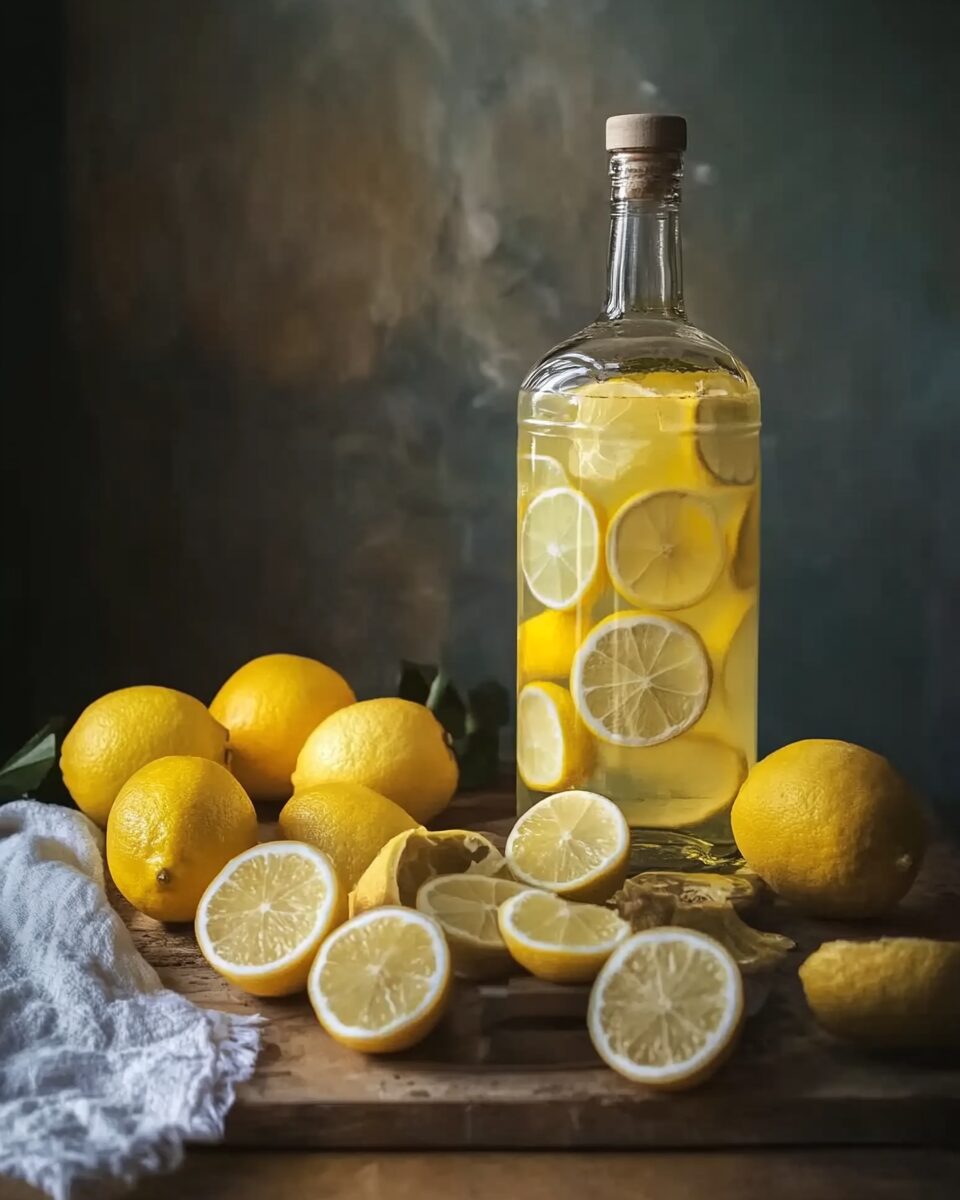This Classic Limoncello is a traditional Italian lemon liqueur that’s perfect for sipping on a warm evening or for serving at parties. The combination of lemon zest, grain alcohol (or vodka), and a simple syrup creates a smooth and refreshing liqueur that captures the essence of fresh lemons. Easy to make and incredibly flavorful, this homemade limoncello will add a zesty twist to your drinks collection.
Full Recipe:
Ingredients
- 10 organic lemons
- 1 liter of 95% grain alcohol (or high-proof vodka if unavailable)
- 1 liter of water
- 700 grams of granulated sugar
Directions
-
Prepare the Lemons:
Wash the lemons thoroughly and pat them dry. Use a peeler or paring knife to carefully remove the yellow zest, avoiding the bitter white pith. -
Steep the Zest:
Place the lemon zest into a large jar and pour in the grain alcohol (or vodka if you’re using that). Seal the jar tightly and let it steep in a cool, dark place for at least 7 days. Shake the jar gently once daily. -
Make the Simple Syrup:
After the steeping period, prepare the simple syrup by boiling water and sugar together until the sugar dissolves. Let the syrup cool to room temperature. -
Strain and Mix:
Strain the lemon-infused alcohol through a fine mesh sieve or cheesecloth to remove the zest. Mix the filtered alcohol with the cooled simple syrup. -
Store and Serve:
Pour the finished limoncello into bottles or jars and seal tightly. Let it rest for at least 2 weeks for the flavors to meld. Serve chilled and enjoy!
Nutrients (Per Serving – 1 oz)
- Calories: 78
- Fat: 0g
- Carbohydrates: 7g
- Sugars: 7g
- Protein: 0g
- Alcohol Content: Approximately 40% ABV (depending on proof of alcohol used)
The Origins of Limoncello
Limoncello has a rich history rooted in southern Italy, particularly the Amalfi Coast, Sorrento, and the island of Capri. These areas are known for their abundant lemon groves, where the prized Sfusato lemon is grown. The fruit’s thick, aromatic skin and bright yellow color are ideal for making Limoncello, which is made by infusing the zest with high-proof alcohol, typically grain alcohol or vodka.
Over time, Limoncello has gained worldwide popularity, transitioning from a local Italian specialty to an internationally recognized beverage. Its vibrant lemon flavor and smooth finish make it a refreshing treat, whether served chilled on its own or incorporated into cocktails and culinary recipes.
Why Make Homemade Limoncello?
While Limoncello is widely available in stores, there’s something special about making it from scratch. Homemade Limoncello allows you to customize the flavor to your liking, ensuring that you use the freshest ingredients and the ideal alcohol base. Making your own batch also allows you to create a liqueur that is uniquely yours and can be shared with friends and loved ones as a personalized gift.
The process of creating Limoncello is simple, requiring just a few ingredients and minimal preparation. The most time-consuming part is the steeping process, which allows the lemon zest to infuse its bright flavor into the alcohol. Once you’ve made your first batch, you’ll find that the process becomes even easier each time, and you’ll never go back to store-bought versions again.
The Ingredients That Make Limoncello Shine
The key to a great homemade Limoncello is the quality of the ingredients you use. Fresh, organic lemons are a must, as the zest is the primary flavoring agent in this liqueur. Opting for organic lemons ensures that you avoid the pesticide residues that may be present on conventionally grown fruit. The bright, vibrant yellow zest from the lemon peel imparts the essential oils, which give Limoncello its signature flavor.
Grain alcohol is traditionally used to make Limoncello because of its neutral taste and high alcohol content, which helps extract the oils from the lemon peel. If grain alcohol is unavailable, high-proof vodka is a great substitute. The alcohol serves as a base, and once infused with the lemon zest, it’s mixed with a simple syrup to balance the tartness of the lemons and create a smoother finish.
Maple syrup or honey can be used as natural sweeteners to replace traditional granulated sugar, providing a unique twist on the flavor profile. However, the classic Limoncello recipe calls for granulated sugar, which complements the tartness of the lemon perfectly.
The Steeping Process: Patience Pays Off
One of the most important steps in making Limoncello is the steeping process. After zesting the lemons, the lemon peel is combined with the high-proof alcohol in a jar and left to steep for a minimum of seven days. This period allows the alcohol to extract the natural oils from the lemon zest, infusing it with a bright, citrusy flavor. The steeping process can be done in a cool, dark place, such as a cupboard or pantry. The jar should be shaken gently once a day to ensure the zest is evenly infused into the liquid.
While the steeping time can be adjusted, it is recommended to let the mixture steep for at least seven days for the best results. Some people prefer to steep it for even longer, up to a month, to intensify the flavor. This waiting period is essential to fully infuse the lemon oils into the alcohol, resulting in the signature tart and aromatic flavor that defines Limoncello.
Straining and Mixing: Creating the Perfect Balance
Once the lemon zest has been infused into the alcohol, the next step is to strain the mixture to remove the zest. This ensures that you are left with a smooth, clean liquid that retains all the citrus flavor but without the bitterness of the zest. Straining can be done using a fine mesh sieve or cheesecloth to ensure no small pieces of zest remain in the mixture.
After straining the mixture, the next step is to combine it with the simple syrup. The syrup helps balance the tartness of the lemon, making the Limoncello smoother and more palatable. The syrup is made by dissolving sugar in water, and some recipes may incorporate orange blossom or rose water to add a floral note to the liqueur. The resulting mixture is the perfect balance of sweetness and acidity.
Storing and Enjoying Limoncello
After the syrup and lemon-infused alcohol are mixed, the Limoncello should be bottled and allowed to rest for at least two weeks. This resting period allows the flavors to meld together and develop, resulting in a more refined, balanced liqueur. The longer you let the Limoncello rest, the smoother and more harmonious the flavors will become. It’s recommended to store Limoncello in the refrigerator or freezer, as it’s traditionally served chilled.
Limoncello is typically enjoyed as a digestif after meals, especially in Italy, where it is served as a refreshing palate cleanser. It can also be used as an ingredient in cocktails or drizzled over desserts like cakes, sorbets, or fruit salads. Whether you enjoy it neat, on the rocks, or as part of a cocktail, Limoncello is a versatile liqueur that adds a bright, zesty flavor to any occasion.
Conclusion: A Taste of Italy in Every Sip
Making your own homemade Limoncello is a rewarding experience that brings the fresh, bright flavors of Italy right to your home. This traditional Italian liqueur is incredibly easy to make, requiring only a few simple ingredients and some patience during the steeping process. The result is a refreshing, zesty drink that’s perfect for sipping on a warm evening, serving at parties, or sharing with friends and family. Whether enjoyed on its own or used as a cocktail ingredient, Limoncello is a timeless beverage that’s sure to impress.
By making Limoncello at home, you not only get to enjoy a truly authentic version of this Italian classic, but you also have the opportunity to customize the sweetness and intensity to suit your personal taste. This recipe is a wonderful way to preserve the essence of fresh lemons and create a delicious, versatile drink that can be enjoyed year-round. So, gather your ingredients, start the steeping process, and soon you’ll have a homemade batch of Limoncello that will bring a little taste of Italy into your life!






